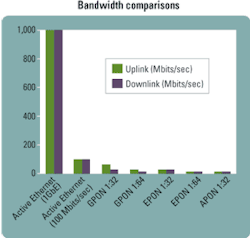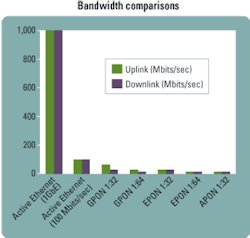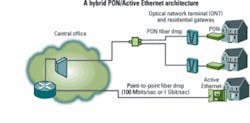by Irit Gillath
Many service providers who have chosen PON for their FTTH deployments are getting more and more requests to deliver higher bandwidth than their network can support. While the standardization bodies are exploring options to solve this problem, there is already a solution that is well established, readily available, and deployed everywhere in the world. Yes, we are talking about Active Ethernet. Active Ethernet, based on the same Ethernet technology that has been in use for more than 30 years, can provide a Gigabit Ethernet (GbE) connection to every customer over the infrastructure that was initially built for PON.
Although PON is a solid technology, consider the limitations. A PON architecture provides shared bandwidth; as Fig. 1 illustrates, the amount of bandwidth can vary depending on the type of PON (EPON, APON, BPON, or GPON) and the type of splitter deployed (1:16, 1:32, or 1:64). Typically, the highest bandwidth that a PON could provide will not exceed (in an optimal deployment) ~60 Mbits/sec, and in many cases the rate will be lower. This bandwidth is available to all customers connected to the same splitter; there is no way to allocate higher bandwidth to one customer over another. This presents a major obstacle to offering higher revenue generating services for customers who request it.
As the need for bandwidth grows�whether due to high-definition (HD) streaming video, gaming, or business needs like remote storage�PON FTTH providers are facing a need to increase the available bandwidth for some customers within their network. If you consider the growing popularity of Web 2.0 applications like YouTube, MySpace, LinkedIn, and Facebook, and the fact that more and more people are purchasing HD-enabled TVs and embracing video conferencing, VoIP, and instant messaging, all signs point to the inevitability that residential users� bandwidth needs will soon equal, if not match, business use. Most consumers assume that their current networks can handle this high video and Web 2.0 content demand and therefore become frustrated and unsatisfied with the service quality as soon as it does not meet their expectations.
Below are just a few examples of applications that require more bandwidth and are commonly used in the home and office. New applications are being introduced almost on a daily basis.
- HDTV channels require roughly 20 Mbits/sec per channel more bandwidth than a regular TV channel.
- Games are hot! According to BusinessWeek magazine, the online gaming market will reach $13 billion by 2011. This would be a 400% increase from the $3.4 billion market last year. The popularity of multiplayer games like World of Warcraft and Halo continue to gain popularity, which is driving demand for higher bandwidth.
- While traditional voice doesn�t require much bandwidth, a high percentage of communication these days is accomplished with video. Applications like Skype, MSN Messenger, AOL, or Yahoo! IM for both private and business communications as well remote learning, virtual conferences, and webinars all require significant bandwidth as well.
- While the bottleneck in the past was more in the downstream link toward the end user, with a growing user population uploading video (did we mention YouTube?), a bigger uplink pipe is going to be required.
- Webcams are gaining acceptance, whether it is for a home security system, parents observing their kids playing in their preschool class, a surveillance system in an entrance to a business, or monitoring the traffic at a congested intersection.
- The iPod, MP3 players, and now iPhones have exponentially increased the amount of media (music and movies) downloaded worldwide, and the adoption of television networks to provide the latest episodes of their series on their web sites (now available also in HD) continues to rise.
- Storage of business information on remote servers is becoming a critical need for companies and requires very high uplink bandwidth.
If you ask anyone who plays an online game, the answer would be as much as possible. A research report from RVA Market Research showed that a typical house with three HDTVs needs more than 50 Mbits/sec. And since networks must serve not only current requirements but also the future needs of the home, we will need a technology that will support bandwidth needs over the next 5 to 10 years and beyond. While some of the technologies provide longer return on investment, Active Ethernet provides bandwidth to suffice for many years to come.
Typically when laying fiber, the cables include a greater number of fiber strands than initially required. The service provider can utilize these unused fibers to serve customers who require higher bandwidth via Active Ethernet technology. The spare fibers can be connected in a point-to-point topology, directly connecting the higher-bandwidth customers with the central office (CO) switch.This strategy enables the service provider to offer a dedicated 1GbE or even 10GbE symmetrical connection to the customer. If less bandwidth is required, the service provider can limit the data rate using features that Ethernet base products support such as traffic shaping and rate limiting.
For example, the service provider could offer dynamic services via a 100-Mbit/sec connection, but if needed, additional bandwidth could be provisioned for a limited amount of time. This bandwidth will be used by the customers on as-needed basis, such as when they need to back up their servers to remote facilities or perform some other transaction that temporarily requires higher bandwidth. The customer would have to pay for the few hours of additional bandwidth only when needed. In fact, some service providers have implemented web management tools that enable the end user to decide the number of hours or days the extra capacity will be needed and the amount of bandwidth that they require, changing their bandwidth in real time to meet their requests (the tools change the configuration of the Ethernet switches).
When building a mixed network of PON and Active Ethernet, the Active Ethernet customers will be connected directly to the CO, without an aggregation point in the field. This means that there are no active components in the outside plant. In the CO, the Active Ethernet and the PON customers are connected to the same CO router/switch and then to the backbone (Fig. 2).
As more customers request higher-bandwidth services, an aggregation point could be put into service between the end users and the CO to ensure that there is a sufficient amount of fiber strands and optimize the use of the available bandwidth. By using bidirectional optical connections, the Active Ethernet portion of the network utilizes only one fiber strand per customer to provide a 100-Mbit/sec, 1-Gbit/sec, or even 10-Gbit/sec Ethernet link per subscriber, with no practical distance limitation.
A hybrid PON and Active Ethernet network provides multiple advantages. First, the service provider can offer differentiated services for businesses and high-end users. This provides higher revenues from the customer who can afford higher-bandwidth service. Moreover, this also allows the service provider to offer additional services that the high-bandwidth availability facilitates, from remote storage to HD video conferencing services.
The combination of the two technologies also enables flexibility in network design as the number of users, type of services, and amount of bandwidth can be easily changed. Service policies and bandwidth allocation can be easily applied using off-the-shelf management systems.
Furthermore, a hybrid approach offers better utilization of the resources available in the network to increase penetration. Active Ethernet also supports link redundancy, which enables survivability and the ability to maintain the service even if one of the fibers is cut or one of the elements in the network has failed.
Although today the service provider might only have a limited amount of customers who request higher bandwidth, this network design also enables a simple and fast option for expansion of the same services to more customers. Expanding the network using a pay-as-you-grow approach, in which Active Ethernet users are added in places where the bandwidth is required, will definitely have its advantages in the long run.
In summary, though PON is well established, its bandwidth limitations dictate a new approach to handle high-bandwidth requirements. Active Ethernet, as an overlay to a PON, will provide a cost-effective, reliable, and flexible network that can meet the bandwidth needs (and demand) in today�s Web 2.0 world and be able to deliver 100 Mbits/sec, 1 Gbit/sec, or even 10 Gbits/sec to the end user, and will ensure that the network of the future will be what end users envision and come to expect for service excellence and reliability.
Irit Gillath is vice president, IP product line, at Telco Systems (www.telco.com).
PON � Passive optical network, which employs a topology of point-to-multipoint, using passive components (splitters) between the central office (CO) and the customer premises. It typically builds from an optical line terminal (OLT) device installed in the service provider CO. It then generates or transfers SONET and DWDM signals over fiber to the optical network unit (ONU) in the field using passive splitters. The bandwidth available for the end user is shared between all the customers who are connected to the same splitter.
APON � ATM passive optical network; uses ATM for transport. Standardized by ITU in 1998, it now is used primarily for small business applications.
BPON � Similar to APON, with extra overlay capabilities for broadband services like video. BPON�s ITU-approved spec is G.983. It supports data rates to 622 Mbits/sec out to an endpoint and back from the customer to the service provider�s remote aggregation point.
GPON � Uses a different, faster approach (up to 2.5 Gbits/sec in current products), encapsulating traffic in a version of the SONET-compatible Generic Framing Protocol (GFP). GPON�s ITU-approved spec is G.984.
EPON � Ethernet PON, which, as its name indicates, is a technique that uses Ethernet as the main transmission method for the PON. EPON runs at gigabit rates and has its own standards defined by the Institute of Electrical and Electronics Engineers (IEEE).
Active Ethernet � A technique that uses Ethernet as the main transmission method over fiber using active components. Active Ethernet runs gigabit rates and it is fully standards based, which ensures full interoperability between vendors. It is sometimes also referred to as a point-to-point network (P2P) because the connection and bandwidth is dedicated to the user. Various QoS and redundancy mechanisms are part of the Ethernet technology standards to enable fully managed services.


